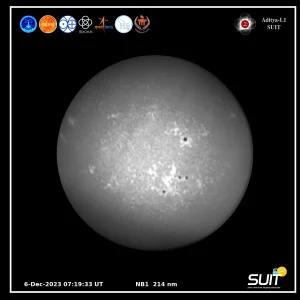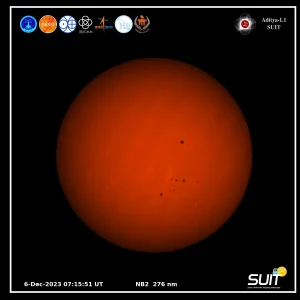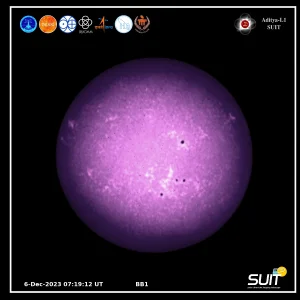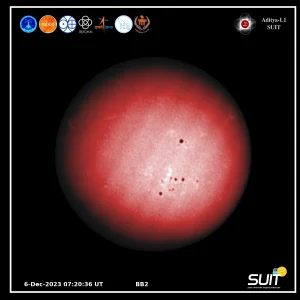You are using an out of date browser. It may not display this or other websites correctly.
You should upgrade or use an alternative browser.
You should upgrade or use an alternative browser.
Aditya L1 and other Indian Missions to the Sun
- Thread starter haldilal
- Start date
More options
Who Replied?- Joined
- Jun 27, 2024
- Messages
- 284
- Likes
- 1,479
From main site
ADITYA-L1
Technical Summary
Science Objectives:
The major science objectives of Aditya-L1 mission are:
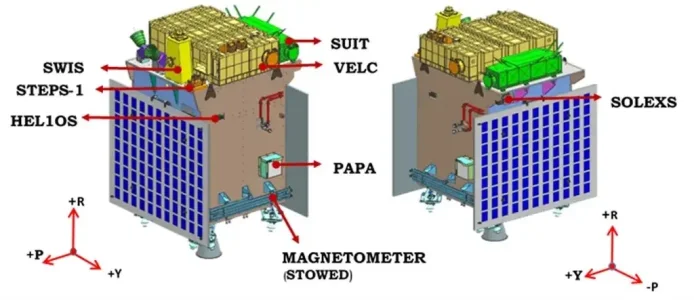
ADITYA-L1
www.isro.gov.in
Technical Summary
Aditya L1 shall be the first space based Indian mission to study the Sun. The spacecraft shall be placed in a halo orbit around the Lagrange point 1 (L1) of the Sun-Earth system, which is about 1.5 million km from the Earth. A satellite placed in the halo orbit around the L1 point has the major advantage of continuously viewing the Sun without any occultation/eclipses. This will provide a greater advantage of observing the solar activities and its effect on space weather in real time. The spacecraft carries seven payloads to observe the photosphere, chromosphere and the outermost layers of the Sun (the corona) using electromagnetic and particle and magnetic field detectors. Using the special vantage point L1, four payloads directly view the Sun and the remaining three payloads carry out in-situ studies of particles and fields at the Lagrange point L1, thus providing important scientific studies of the propagatory effect of solar dynamics in the interplanetary medium
The suits of Aditya L1 payloads are expected to provide most crucial informations to understand the problem of coronal heating, coronal mass ejection, pre-flare and flare activities and their characteristics, dynamics of space weather, propagation of particle and fields etc.
Science Objectives:
The major science objectives of Aditya-L1 mission are:
- Study of Solar upper atmospheric (chromosphere and corona) dynamics.
- Study of chromospheric and coronal heating, physics of the partially ionized plasma, initiation of the coronal mass ejections, and flares
- Observe the in-situ particle and plasma environment providing data for the study of particle dynamics from the Sun.
- Physics of solar corona and its heating mechanism.
- Diagnostics of the coronal and coronal loops plasma: Temperature, velocity and density.
- Development, dynamics and origin of CMEs.
- Identify the sequence of processes that occur at multiple layers (chromosphere, base and extended corona) which eventually leads to solar eruptive events.
- Magnetic field topology and magnetic field measurements in the solar corona .
- Drivers for space weather (origin, composition and dynamics of solar wind.

The instruments of Aditya-L1 are tuned to observe the solar atmosphere mainly the chromosphere and corona. In-situ instruments will observe the local environment at L1. There are total seven payloads on-board with four of them carrying out remote sensing of the Sun and three of them carrying in-situ observation.
- Joined
- Jun 27, 2024
- Messages
- 284
- Likes
- 1,479
Payloads along with their major capability of scientific investigation.
Remote Sensing Payloads
| Payload | Capability |
| Visible Emission Line Coronagraph(VELC) | Corona/Imaging & Spectroscopy |
| Solar Ultraviolet Imaging Telescope (SUIT) | Photosphere and Chromosphere Imaging- Narrow & Broadband |
| Solar Low Energy X-ray Spectrometer (SoLEXS) | ]Soft X-ray spectrometer: Sun-as-a-star observation |
| High Energy L1 Orbiting X-ray Spectrometer(HEL1OS) | Hard X-ray spectrometer: Sun-as-a-star observation |
In-situ Payloads
| Payload | Capability |
| Aditya Solar wind Particle Experiment(ASPEX) | Solar wind/Particle Analyzer Protons & Heavier Ions with directions |
| Plasma Analyser Package For Aditya (PAPA)[/BGCOLOR] | Solar wind/Particle Analyzer Electrons & Heavier Ions with directions |
| Advanced Tri-axial High Resolution Digital Magnetometers | In-situ magnetic field (Bx, By and Bz) |
Last edited:
- Joined
- Jun 27, 2024
- Messages
- 284
- Likes
- 1,479
Post-launch Mission Timeline
PSLV-C57/Aditya-L1 Mission
January 25, 2024
Successful Deployment of Magnetometer Boom on Aditya-L1 in Halo Orbit
January 6, 2024
Aditya-L1 solar observatory is successfully inserted into Halo-Orbit around Sun-Earth L1
December 8, 2023
In-orbit Health Status of Plasma Analyser Package for Aditya (PAPA)
The SUIT payload captures full-disk images of the Sun in near ultraviolet wavelengths
December 1, 2023
Solar wind Ion Spectrometer (SWIS) in the Aditya Solar wind Particle Experiment(ASPEX) payload is made operational
November 7, 2023
HEL1OS captures first High-Energy X-ray glimpse of Solar Flares
October 8, 2023
A Trajectory Correction Maneuvre (TCM), originally provisioned, was performed on October 6, 2023, for about 16 s. It was needed to correct the trajectory evaluated after tracking the Trans-Lagrangean Point 1 Insertion (TL1I) maneuvre performed on September 19, 2023. TCM ensures that the spacecraft is on its intended path towards the Halo orbit insertion around L1
September 30, 2023
The spacecraft has escaped the sphere of Earth's influence, on its way to the Sun-Earth Lagrange Point 1(L1).
September 25, 2023
An assessment of space situation around Sun-Earth Lagrange Point L1
September 19, 2023
The spacecraft is currently travelling to the Sun-Earth L1 point.
September 18, 2023
Aditya-L1 has commenced the collection of scientific data.
September 15, 2023
Fourth Earth-bound maneuvre (EBN#4) is performed successfully. The new orbit attained is 256 km x 121973 km.
September 10, 2023
Third Earth-bound maneuvre (EBN#3) is performed successfully. The new orbit attained is 296 km x 71767 km.
September 05, 2023
Second Earth-bound maneuvre (EBN#2) is performed successfully. The new orbit attained is 282 km x 40225 km.
September 03, 2023
The next maneuvre (EBN#2) is scheduled for September 5, 2023, around 03:00 Hrs. IST
The first Earth-bound maneuvre (EBN#1) is performed successfully from ISTRAC, Bengaluru. The new orbit attained is 245 km x 22459 km
The satellite is healthy and operating nominally
September 02, 2023
India's first solar observatory has begun its journey to the destination of Sun-Earth L1 point
The vehicle has placed the satellite precisely into its intended orbit
The launch of Aditya-L1 by PSLV-C57 is accomplished successfully
- Joined
- Jun 27, 2024
- Messages
- 284
- Likes
- 1,479
PSLV C-57 Liftoff Video (Site URL)
Aditya L1 Videos (Site URL)
1. Aditya-L1 images its instruments, the Earth and the Moon in Space
2. Realisation of ADITYA-L1 Scientific Payloads
3. Operation of Alpha Particle Xray Spectroscope
PSLV-C57 Lift off video
www.isro.gov.in
Aditya L1 Videos (Site URL)
Aditya-L1 Videos
www.isro.gov.in
2. Realisation of ADITYA-L1 Scientific Payloads
3. Operation of Alpha Particle Xray Spectroscope
- Joined
- Jun 27, 2024
- Messages
- 284
- Likes
- 1,479
Pre-Launch Prospecta.
Aditya-L1 Mission and Science Payloads (PDF File)
Aditya-L1 Mission Booklet (PDF File)
Mission Brochure (PDF file)
Aditya-L1 Mission and Science Payloads (PDF File)
Aditya-L1 Mission Booklet (PDF File)
Mission Brochure (PDF file)
- Joined
- Jun 27, 2024
- Messages
- 284
- Likes
- 1,479
Insertion into Halo Orbit
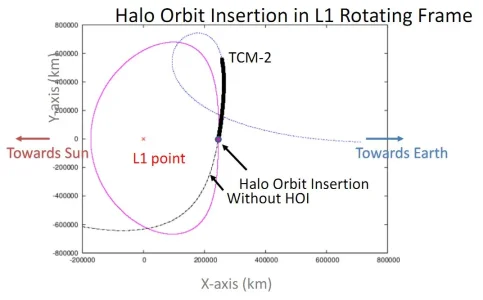
Halo-Orbit Insertion of Aditya-L1 Successfully Accomplished
www.isro.gov.in

- Joined
- Jun 27, 2024
- Messages
- 284
- Likes
- 1,479
Older News
(Images from SWAP instrument from NASA)
Novel technique for tracking solar eruptions that disrupt space weather to be used in India’s first solar mission
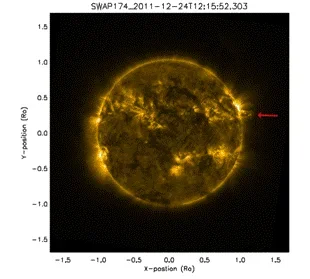
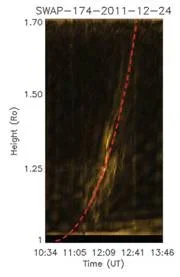
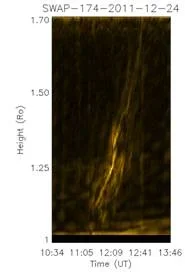
(a) (b) (c)
Figure 1: (a) Solar corona observed in EUV image of SWAP instrument. An erupting structure at the west limb is pointed at by the red arrow, (b) height-time plot corresponding to the eruption. A parabolic profile could be observed, (c) Identified parabolic profile by CIISCO overplotted on (b) by dashed line.
(Images from SWAP instrument from NASA)
Novel technique for tracking solar eruptions that disrupt space weather to be used in India’s first solar mission
Scientists have developed a new technique to track the huge bubbles of gas threaded with magnetic field lines that are ejected from the Sun, disrupting space weather and causing geomagnetic storms, satellite failures, and power outages.
As the ejections from the Sun, technically called Coronal Mass Ejections (CMEs), cause various disturbances of the space environment, forecasting their arrival time is very important. However, forecasting accuracy is hindered by limited CME observations in interplanetary space.
Software named Computer Aided CME Tracking Software (CACTus) based on a computer vision algorithm was so far used to detect and characterise such eruptions automatically in the outer corona where these eruptions cease to show accelerations and propagate with a nearly constant speed.
However, this algorithm could not be applied to the inner corona observations due to the vast acceleration experienced by these eruptions. This severely limited the capability to track the eruptions as CMEs accelerate in the lower corona. Moreover, with the advancement in space technology, there has been a tremendous increase in the amount of data obtained from spacecraft. To identify and track the solar eruptions in huge number of images can become tedious if done manually.
Research led by Mr. Ritesh Patel, Dr. Vaibhav Pant, and Prof. Dipankar Banerjee from Aryabhatta Research Institute of observational sciences (ARIES), Nainital, an autonomous institute under DST, Government of India, along with their collaborators from Royal Observatory of Belgium, have led to the development of an algorithm, CMEs Identification in Inner Solar Corona (CIISCO) to detect and track the accelerating solar eruption in the lower corona. CIISCO has been successfully tested on several eruptions observed by space observatories, including Solar Dynamics Observatory and Solar-Terrestrial Relations Observatory, PROBA2/SWAP launched by NASA and ESA, respectively. The research was published in the Solar Physics journal.



(a) (b) (c)
Figure 1: (a) Solar corona observed in EUV image of SWAP instrument. An erupting structure at the west limb is pointed at by the red arrow, (b) height-time plot corresponding to the eruption. A parabolic profile could be observed, (c) Identified parabolic profile by CIISCO overplotted on (b) by dashed line.
The parameters determined by CIISCO are useful to characterise these eruption in the lower corona, a region where the properties of such eruptions are less known. An implementation of CIISCO on the large volume of data available from space observatories mentioned above will be helpful to improve our understanding of eruptions in the inner corona. As India’s first solar mission, Aditya-L1, will be observing this region of the solar corona, implementation of CIISCO on the Aditya-L1 data will provide new insight into the CME properties in this less explored region.
- Joined
- Jun 27, 2024
- Messages
- 284
- Likes
- 1,479
Jun 22, 2021
Unraveling the mysteries of the Solar Corona: New results from Chandrayaan-2 Solar X-ray Monitor
Publications:
Astrophysical Journal Letters, Vol. 912, Id. L12 (7pp), 2021, https://doi.org/10.3847/2041-8213/abf35d
Unraveling the mysteries of the Solar Corona: New results from Chandrayaan-2 Solar X-ray Monitor
Our Sun, being the primary source of energy for our solar system has a significant influence on our lives, and has always instilled a curiosity in humankind.. Though we have a fairly good understanding of the origin of energy and other various aspects of the Sun, several potentially life-changing phenomena still remain a mystery. Being the nearest star, understanding the Sun also allows us to learn about other distant stars better.
A team of scientists from the Physical Research Laboratory (PRL), Ahmedabad, used observations of the Sun in soft X-rays with Solar X-ray Monitor (XSM) onboard ISRO's Chandrayaan-2 mission during the deepest solar minimum of the past hundred years to learn exciting details about the solar corona. For the first time, absolute abundances of elemental Mg, Al, Si in the quiet solar corona are derived. The team discovered and characterized around 100 “sub-A class” microflares in the quiet corona providing new insight into coronal heating puzzle.Some of these mysteries are related to the hot outer atmosphere of the Sun, known as ‘corona’, which emits profusely in ultra-violet and X-ray wavelengths of the electromagnetic spectrum. We know that the corona consists of ionized gas at temperatures exceeding one million Kelvin, which is much higher than photospheric temperature of 6000 K, the visible surface temperature of the Sun. However, this observation is against the natural expectation that the temperatures should reduce as we go away from the source of energy, and this is known as the ‘coronal heating problem’. From observations, such as the presence of even hotter corona, called active regions above the Sunspots (dark patches seen in visible images of the Sun) where the magnetic fields are known to be stronger, it is suggested that the magnetic fields have an important role in the coronal heating. While there are different theories regarding the actual mechanism, one of these relies on the occurrence of a large number of small solar flares called ‘nanoflares’. Another puzzling observation about the corona is that certain elements are found to have abundances three to four times higher in active regions than in the photosphere. This happens for elements which are easier to ionize, or require lesser energy to ionize. In more technical terms, these elements have their First Ionization Potential (FIP) lower than 10 eV, and hence this phenomenon is generally termed as ‘FIP bias’. The exact reason behind the FIP bias and its origin remains an open question.
The XSM, designed and developed by PRL with support from various ISRO centres, provides measurement of soft X-ray (1-15 keV) spectrum of the Sun. The XSM also supports the quantitative measurements of elemental abundances of the lunar surface using the companion payload CLASS (Chandrayaan-2 Large Area Soft X-ray Spectrometer) developed by URSC, Bangalore, which measures the X-ray fluorescence spectrum from the lunar surface. At present, XSM is the only instrument that provides soft X-ray spectral measurements of the Sun, i.e., measures the intensity of X-ray in different energies over the 1 to 15 keV. More importantly, XSM provides such measurements with very good energy resolution at every second, the highest cadence for any instrument so far.
XSM started observations of the Sun in September 2019, during the period of solar minimum when typically there were very few Sunspots and active regions on the Sun. The solar minimum of 2019-2020 was even more peculiar as the Sun was extremely quiet, and its activity was at the lowest level over the past century. This provided a unique opportunity for XSM to observe the quiet corona without active regions for long periods. The solar X-ray flux as observed by the XSM during this period is shown in the figure. Intervals highlighted with blue color correspond to a period of 76 days when no active regions were present on the solar disk, and XSM was observing the quiet corona.
A remarkable and surprising observation is the detection of a large number (98) of extremely small flares in the quiet corona (see Figure below). These flares are so small that their intensity is well below the standard scale to classify solar flares (i.e. A, B, C, M, and X class flares, where each class is 10 times more intense than previous), and hence these are termed as “sub-A class microflares”. Using the X-ray spectra of these microflares obtained with the XSM and contemporary images in Extreme Ultra-violet obtained with the Atmospheric Imaging Assembly (AIA) of NASA's Solar Dynamics Observatory (SDO), the energy content of these flares could be estimated. This was the first observation and statistical study of such a large sample of microflares in the quiet Sun, supporting the hypothesis of the presence of even smaller scale flares everywhere on the solar corona that could be responsible for the coronal heating.
The X-ray emission over these 76 days, excluding the durations of the microflares, is unusually constant. This is the lowest intensity of X-ray emission observed from the Sun since space-borne observations began. Analysis of the XSM spectra of the quiet Sun, excluding the microflares, provided the measurement of abundances of various elements. The abundances of the low FIP elements Mg, Al, and Si were estimated and found to be lower than the abundances seen in active region corona but higher than that in the photosphere. This is the first report of measurement of abundances as well as reduced FIP bias in the quiet Sun. Our observations of FIP bias in the quiet Sun provides significant inputs towards understanding the FIP bias and suggests that it arises due to the presence of Alfvén waves in the closed magnetic loops.
These outstanding science results on the solar corona and heliophysics obtained during a unique solar extremely quiet period using a sensitive instrument XSM aboard Chandryayaan-2 observations are published in two companion papers in the May issue of the Astrophysical Journal Letters.
Figure : Panels (a) and (b) show the X-ray flux in the 1–15 keV energy range with a time cadence of 120 seconds, as measured by the XSM during two observing seasons. Different background shades represent activity levels on the Sun, with orange representing periods when active regions are present; pink representing periods of enhanced activity visible in both the XSM light curve as well as EUV/X-ray images but not classified as Active Regions; and blue representing periods selected for the present study when no major activity was observed on the Sun. The micro flares detected during the quiet periods are marked with red points, representing their peaks; and red vertical bars, representing their time.Both the Chandrayaan-2 orbiter and the XSM instrument are performing extremely well, and expected to provide many more exciting and new results.
Publications:
- "Observations of the Quiet Sun During the Deepest Solar Minimum of the Past Century with Chandrayaan-2 XSM: Elemental Abundances in the Quiescent Corona”
Astrophysical Journal Letters, Vol. 912, Id. L12 (7pp), 2021, https://doi.org/10.3847/2041-8213/abf35d
- "Observations of the Quiet Sun During the Deepest Solar Minimum of the Past Century with Chandrayaan-2 XSM: Sub-A Class Microflares Outside Active Regions”
- Joined
- Jun 27, 2024
- Messages
- 284
- Likes
- 1,479
- Joined
- Jun 27, 2024
- Messages
- 284
- Likes
- 1,479
From dead link
Indian Mars Orbiter Mission (MOM) used for Investigating the Solar Corona by ISRO Scientists
Utilizing the solar conjunction event, when the Earth and Mars are on the opposite sides of the Sun, a team of scientists from Space Physics Laboratory of Vikram Sarabhai Space Centre, Trivandrum; Physical Research Laboratory, Ahmedabad; and ISRO Telemetry Tracking and Command Network (ISTRAC), Bangalore; used S-band radio signals coming from the Indian Mars Orbiter Mission (MOM) to study the Solar Corona. During conjunction events, which usually happens once in approximately two years for Mars, the radio signals from MOM passes through the solar corona, as close as 10 solar radii (1 solar radii (Rʘ) = 696,340 km = about 100 Earth radii), from the center of the Sun, thus providing a unique opportunity to study solar dynamics. ISRO scientists used the conjunction event of May-June 2015 – a time when the Sun's activity was quite low, to study the turbulence in the solar corona and found that transition of solar wind from sub-alfvenic to super-alfvenic flow occurs around 10–15 Rʘ during low solar activity period.
The outer atmosphere of the Sun, called the solar corona, is the region where the temperature is several million degrees Kelvin, rendering it quite inaccessible for in-situ measurements thereby challenging the experimenters. The reason for such a high temperature of the corona is still an enigma. The solar wind, which originates in the corona and accelerates in this region, passes through the interplanetary spaces, shapes the magnetosphere of planets, as well as affects the near-Earth space environment through a phenomenon known as "Space Weather".
Since the solar corona is an ionized medium (plasma) and has its intrinsic turbulence, it is a dispersive medium for an electromagnetic radio wave passing through it. The radio signals from MOM spacecraft crossing through the solar corona during the conjunction event (cf. Figure 1) consequently experience dispersive effects. The turbulence in the corona produces fluctuations in plasma density which get registered as fluctuations in the phase of radio waves passing through it. Thus, the radio signals received at the ground station (Indian Deep Space Network, ISTRAC for MOM) contain the signature of propagating medium (solar corona) and can be spectrally analyzed to derive the turbulence spectrum of the medium. This forms the basis of the coronal radio-sounding technique which has been used by spacecraft to study coronal regions spanning maximum and minimum phases of different solar cycles.
ISRO scientists obtained coronal turbulence spectrum at heliocentric distances between 4 and 20 Rʘ by spectrally analyzing the Doppler frequency residuals from radio signals received from MOM spacecraft. This is the region where the solar wind primarily gets accelerated to velocities of a few hundreds of kilometers per second. The changes in turbulence regime are well reflected in spectral index values of the temporal frequency fluctuation spectrum. The scientists found that the turbulence power spectrum at a lower heliocentric distance (<10 Rʘ) has flattened at shorter frequencies with a smaller spectral index, which corresponds to the solar wind acceleration region. Smaller spectral index values closer to the Sun’s surface signify the energy input regime where turbulence is still underdeveloped. For larger heliocentric distances (> 10 Rʘ), the curve steepens with a spectral index close to 2/3, which is indicative of the inertial regime of a developed Kolmogorov-type turbulence, where energy is transported through cascading. This finding is consistent with those of theoretical models of solar wind turbulence and substantiates the process of turbulence energy transport and dissipation of magnetohydrodynamic waves, leading to coronal heating and solar wind acceleration in the near-Sun region.
Incidentally, this finding of ISRO scientists is also supported by the first direct observation of solar corona by Parker Probe, published very recently in an independent study.
Another intriguing observation is when the results of studies by MOM are compared with similar experiments conducted by the earlier missions which spanned past solar cycles. The work based on MOM data reports an insight into the feeble maxima of solar cycle 24, which is recorded as a peculiar solar cycle in terms of overall lower activity than any other previous solar cycle.
These outstanding science results on the solar coronal dynamics using MOM in an innovative way is published in the refereed journal Monthly Notices of the Royal Astronomical Society, titled "A study on the solar coronal dynamics during the post-maxima phase of the solar cycle 24 using S-band radio signals from the Indian Mars Orbiter Mission", authored by Richa N. Jain,R. K. Choudhary, Anil Bhardwaj, Umang Parikh, Bijoy K. Dai, and Roopa M. V.
Monthly Notices of the Royal Astronomical Society, DOI: 10.1093/mnras/stac056
https://academic.oup.com/mnras/advance-article-abstract/doi/10.1093/mnras/stac056/6506470
PS: - India’s first mission to Mars, the MOM, was launched on 5 November 2013, and arrived at Mars on 24 September 2014. The MOM was planned for a mission lifetime of 6 months, but has successfully surpassed it by a factor of 10 – now in Martian orbit for more than 7 years, and is doing well in the extended mission phase. The MOM has provided the first measurements of the evening time exosphere of Mars (1) and has discovered hot Argon in its upper atmosphere-exosphere by the MENCA experiment onboard MOM (2).
(1) MENCA observed the evening exosphere of Mars
(2) Observation of Suprathermal Argon in Mars Exosphere

Figure 1. Schematic of positions of Earth and MOM spacecraft relative to the Ecliptic plane of Sun (XY plane) as seen from Earth. Radio signals sent by spacecraft (dashed line) pass closer to the solar coronal region during this period.
Indian Mars Orbiter Mission (MOM) used for Investigating the Solar Corona by ISRO Scientists
Utilizing the solar conjunction event, when the Earth and Mars are on the opposite sides of the Sun, a team of scientists from Space Physics Laboratory of Vikram Sarabhai Space Centre, Trivandrum; Physical Research Laboratory, Ahmedabad; and ISRO Telemetry Tracking and Command Network (ISTRAC), Bangalore; used S-band radio signals coming from the Indian Mars Orbiter Mission (MOM) to study the Solar Corona. During conjunction events, which usually happens once in approximately two years for Mars, the radio signals from MOM passes through the solar corona, as close as 10 solar radii (1 solar radii (Rʘ) = 696,340 km = about 100 Earth radii), from the center of the Sun, thus providing a unique opportunity to study solar dynamics. ISRO scientists used the conjunction event of May-June 2015 – a time when the Sun's activity was quite low, to study the turbulence in the solar corona and found that transition of solar wind from sub-alfvenic to super-alfvenic flow occurs around 10–15 Rʘ during low solar activity period.
The outer atmosphere of the Sun, called the solar corona, is the region where the temperature is several million degrees Kelvin, rendering it quite inaccessible for in-situ measurements thereby challenging the experimenters. The reason for such a high temperature of the corona is still an enigma. The solar wind, which originates in the corona and accelerates in this region, passes through the interplanetary spaces, shapes the magnetosphere of planets, as well as affects the near-Earth space environment through a phenomenon known as "Space Weather".
Since the solar corona is an ionized medium (plasma) and has its intrinsic turbulence, it is a dispersive medium for an electromagnetic radio wave passing through it. The radio signals from MOM spacecraft crossing through the solar corona during the conjunction event (cf. Figure 1) consequently experience dispersive effects. The turbulence in the corona produces fluctuations in plasma density which get registered as fluctuations in the phase of radio waves passing through it. Thus, the radio signals received at the ground station (Indian Deep Space Network, ISTRAC for MOM) contain the signature of propagating medium (solar corona) and can be spectrally analyzed to derive the turbulence spectrum of the medium. This forms the basis of the coronal radio-sounding technique which has been used by spacecraft to study coronal regions spanning maximum and minimum phases of different solar cycles.
ISRO scientists obtained coronal turbulence spectrum at heliocentric distances between 4 and 20 Rʘ by spectrally analyzing the Doppler frequency residuals from radio signals received from MOM spacecraft. This is the region where the solar wind primarily gets accelerated to velocities of a few hundreds of kilometers per second. The changes in turbulence regime are well reflected in spectral index values of the temporal frequency fluctuation spectrum. The scientists found that the turbulence power spectrum at a lower heliocentric distance (<10 Rʘ) has flattened at shorter frequencies with a smaller spectral index, which corresponds to the solar wind acceleration region. Smaller spectral index values closer to the Sun’s surface signify the energy input regime where turbulence is still underdeveloped. For larger heliocentric distances (> 10 Rʘ), the curve steepens with a spectral index close to 2/3, which is indicative of the inertial regime of a developed Kolmogorov-type turbulence, where energy is transported through cascading. This finding is consistent with those of theoretical models of solar wind turbulence and substantiates the process of turbulence energy transport and dissipation of magnetohydrodynamic waves, leading to coronal heating and solar wind acceleration in the near-Sun region.
Incidentally, this finding of ISRO scientists is also supported by the first direct observation of solar corona by Parker Probe, published very recently in an independent study.
Another intriguing observation is when the results of studies by MOM are compared with similar experiments conducted by the earlier missions which spanned past solar cycles. The work based on MOM data reports an insight into the feeble maxima of solar cycle 24, which is recorded as a peculiar solar cycle in terms of overall lower activity than any other previous solar cycle.
These outstanding science results on the solar coronal dynamics using MOM in an innovative way is published in the refereed journal Monthly Notices of the Royal Astronomical Society, titled "A study on the solar coronal dynamics during the post-maxima phase of the solar cycle 24 using S-band radio signals from the Indian Mars Orbiter Mission", authored by Richa N. Jain,R. K. Choudhary, Anil Bhardwaj, Umang Parikh, Bijoy K. Dai, and Roopa M. V.
Monthly Notices of the Royal Astronomical Society, DOI: 10.1093/mnras/stac056
https://academic.oup.com/mnras/advance-article-abstract/doi/10.1093/mnras/stac056/6506470
PS: - India’s first mission to Mars, the MOM, was launched on 5 November 2013, and arrived at Mars on 24 September 2014. The MOM was planned for a mission lifetime of 6 months, but has successfully surpassed it by a factor of 10 – now in Martian orbit for more than 7 years, and is doing well in the extended mission phase. The MOM has provided the first measurements of the evening time exosphere of Mars (1) and has discovered hot Argon in its upper atmosphere-exosphere by the MENCA experiment onboard MOM (2).
(1) MENCA observed the evening exosphere of Mars
(2) Observation of Suprathermal Argon in Mars Exosphere

Figure 1. Schematic of positions of Earth and MOM spacecraft relative to the Ecliptic plane of Sun (XY plane) as seen from Earth. Radio signals sent by spacecraft (dashed line) pass closer to the solar coronal region during this period.
- Joined
- Jun 27, 2024
- Messages
- 284
- Likes
- 1,479
Feb 23, 2022
Chandrayaan-2 detected solar proton events due to high intensity solar flares in January 2022.
When Sun is active, spectacular eruptions called solar flares occur that sometimes also spew out energetic particles (called Solar Proton Events or SPEs) into interplanetary space. Most of these are high energy protons that impact space systems and significantly increase radiation exposure to humans in space. They can cause ionisation on large scales in Earth's middle atmosphere. Many intense solar flares are accompanied by coronal mass ejections (CMEs), a powerful stream of ionised material and magnetic fields, which reach Earth a few days later, leading to geomagnetic storms and lighting up the polar sky with auroras.
Solar flares are classified according to their strength. The smallest ones are A-class, followed by B, C, M and X. Each letter represents a 10-fold increase in energy output. This means that an M class flare is ten times intense than C-class flare and 100 times intense than B-class flare. Within each letter class there is a finer scale from 1 to 9 i.e a M2 flare is twice the strength of M1 flare.
Recently, there were two M-class solar flares. One flare (M5.5) spewed out energetic particles into interplanetary space and the other flare (M1.5) was accompanied by a Coronal Mass Ejection (CME). SPE event was seen by NASA's Geostationary Operational Environmental Satellite (GOES) satellite orbiting around Earth. However, the CME event was not detected by GOES.
Chandrayaan-2 Large Area Soft X-ray Spectrometer (CLASS) on-board Chandrayaan-2 Orbiter detected SPE due to an M5.5 class solar flare that occurred on January 20, 2022 (blue curve). The red curve shows the proton counts due to SPE recorded by GOES satellite operated by NOAA.

CLASS instrument also detected CME event as it passed through the moon due to an M1.5 class solar flare that occurred on Jan 18. CME travels with a speed of about 1000 km/s and it takes about 2-3 days to reach Earth. The signature of this event is missed by GOES satellite, as Earth magnetic field provides shielding from such events. However, the event was recorded by Chandrayaan-2.

Shown in both graphs is the arrival rate of protons recorded by CLASS payload versus time (in UTC). Integral flux is defined as total number of protons above an energy (or within an energy range) per second per unit detector area. In the present case, energy of proton is greater than 11.6 MeV.
Thus, CLASS payload on Chandrayaan-2 saw both the SPE and CME events pass by from two intense flares on the Sun. Such multi point observations help us understand the propagation and its impact on different planetary systems.
Ctsy: ISRO website.
For some reason, I
Chandrayaan-2 detected solar proton events due to high intensity solar flares in January 2022.
When Sun is active, spectacular eruptions called solar flares occur that sometimes also spew out energetic particles (called Solar Proton Events or SPEs) into interplanetary space. Most of these are high energy protons that impact space systems and significantly increase radiation exposure to humans in space. They can cause ionisation on large scales in Earth's middle atmosphere. Many intense solar flares are accompanied by coronal mass ejections (CMEs), a powerful stream of ionised material and magnetic fields, which reach Earth a few days later, leading to geomagnetic storms and lighting up the polar sky with auroras.
Solar flares are classified according to their strength. The smallest ones are A-class, followed by B, C, M and X. Each letter represents a 10-fold increase in energy output. This means that an M class flare is ten times intense than C-class flare and 100 times intense than B-class flare. Within each letter class there is a finer scale from 1 to 9 i.e a M2 flare is twice the strength of M1 flare.
Recently, there were two M-class solar flares. One flare (M5.5) spewed out energetic particles into interplanetary space and the other flare (M1.5) was accompanied by a Coronal Mass Ejection (CME). SPE event was seen by NASA's Geostationary Operational Environmental Satellite (GOES) satellite orbiting around Earth. However, the CME event was not detected by GOES.
Chandrayaan-2 Large Area Soft X-ray Spectrometer (CLASS) on-board Chandrayaan-2 Orbiter detected SPE due to an M5.5 class solar flare that occurred on January 20, 2022 (blue curve). The red curve shows the proton counts due to SPE recorded by GOES satellite operated by NOAA.

CLASS instrument also detected CME event as it passed through the moon due to an M1.5 class solar flare that occurred on Jan 18. CME travels with a speed of about 1000 km/s and it takes about 2-3 days to reach Earth. The signature of this event is missed by GOES satellite, as Earth magnetic field provides shielding from such events. However, the event was recorded by Chandrayaan-2.

Shown in both graphs is the arrival rate of protons recorded by CLASS payload versus time (in UTC). Integral flux is defined as total number of protons above an energy (or within an energy range) per second per unit detector area. In the present case, energy of proton is greater than 11.6 MeV.
Thus, CLASS payload on Chandrayaan-2 saw both the SPE and CME events pass by from two intense flares on the Sun. Such multi point observations help us understand the propagation and its impact on different planetary systems.
Ctsy: ISRO website.
For some reason, I
- Joined
- Jun 27, 2024
- Messages
- 284
- Likes
- 1,479

India aims to predict how & when Sun eruptions will hit Earth. Isro chief gives details about Aditya L-1
Isro chief S Somnath was at the India Today Conclave South 2023 to discuss the space quest.

The Solar Ultraviolet Imaging Telescope (SUIT)
- Joined
- Jun 27, 2024
- Messages
- 284
- Likes
- 1,479
Aditya-L1's SUIT captures full-disk images of the Sun in near ultraviolet wavelengths
December 8, 2023
The Solar Ultraviolet Imaging Telescope (SUIT) instrument on board the Aditya-L1 spacecraft has successfully captured the first full-disk images of the Sun in the 200-400 nm wavelength range. SUIT captures images of the Sun's photosphere and chromosphere in this wavelength range using various scientific filters.
On November 20, 2023, the SUIT payload was powered ON. Following a successful pre-commissioning phase, the telescope captured its first light science images on December 6, 2023. These unprecedented images, taken using eleven different filters (as shown in Table 1), include the first-ever full-disk representations of the Sun in wavelengths ranging from 200 to 400 nm, excluding Ca II h. The full disk images of the Sun in the Ca II h wavelength has been studied from other observatories.
Among the notable features revealed are sunspots, plage, and quiet Sun regions, as marked in the Mg II h image, providing scientists with pioneering insights into the intricate details of the Sun's photosphere and chromosphere. SUIT observations will help scientists study the dynamic coupling of the magnetized solar atmosphere and assist them in placing tight constraints on the effects of solar radiation on Earth's climate
The development of SUIT involved a collaborative effort under the leadership of the Inter-University Centre for Astronomy and Astrophysics (IUCAA), Pune. This collaboration included ISRO, the Manipal Academy of Higher Education (MAHE), the Centre for Excellence in Space Science Indian (CESSI) at IISER-Kolkata, the Indian Institute of Astrophysics Bengaluru, the Udaipur Solar Observatory (USO-PRL), and Tezpur University Assam.
December 8, 2023
The Solar Ultraviolet Imaging Telescope (SUIT) instrument on board the Aditya-L1 spacecraft has successfully captured the first full-disk images of the Sun in the 200-400 nm wavelength range. SUIT captures images of the Sun's photosphere and chromosphere in this wavelength range using various scientific filters.
On November 20, 2023, the SUIT payload was powered ON. Following a successful pre-commissioning phase, the telescope captured its first light science images on December 6, 2023. These unprecedented images, taken using eleven different filters (as shown in Table 1), include the first-ever full-disk representations of the Sun in wavelengths ranging from 200 to 400 nm, excluding Ca II h. The full disk images of the Sun in the Ca II h wavelength has been studied from other observatories.
Among the notable features revealed are sunspots, plage, and quiet Sun regions, as marked in the Mg II h image, providing scientists with pioneering insights into the intricate details of the Sun's photosphere and chromosphere. SUIT observations will help scientists study the dynamic coupling of the magnetized solar atmosphere and assist them in placing tight constraints on the effects of solar radiation on Earth's climate
The development of SUIT involved a collaborative effort under the leadership of the Inter-University Centre for Astronomy and Astrophysics (IUCAA), Pune. This collaboration included ISRO, the Manipal Academy of Higher Education (MAHE), the Centre for Excellence in Space Science Indian (CESSI) at IISER-Kolkata, the Indian Institute of Astrophysics Bengaluru, the Udaipur Solar Observatory (USO-PRL), and Tezpur University Assam.
- Joined
- Jun 27, 2024
- Messages
- 284
- Likes
- 1,479
| Name of the filter (emission lines) | Wavelength (nm) | Features |
| NB1 | 214 | Photosphere, Sunspot, Plages and limb darkening |
| NB2 | 276 | Photosphere, Sunspot, Plages, limb darkening |
| NB3 (Mg II k) | 279 | Chromosphere, Sunspots, Plages, Quiet Sun, filaments |
| NB4 (Mg II h) | 280 | Chromosphere, Sunspots, Plages, Quiet Sun, filaments |
| NB5 | 283 | Photosphere, Sunspot, Plages, limb darkening |
| NB6 | 300 | Photosphere, Sunspot, Plages, limb darkening |
| NB7 | 388 | Photosphere, Sunspot, limb darkening |
| NB8 (Ca II h) | 396.8 | Chromosphere, Sunspots, Plages, Quiet Sun. |
| BB1 | 200-242 | Photosphere, limb darkening, Plages, Sunspots |
| BB2 | 242-300 | Photosphere, limb darkening, Plages, Sunspots |
| BB3 | 320-360 | Photosphere, limb darkening, Sunspots |
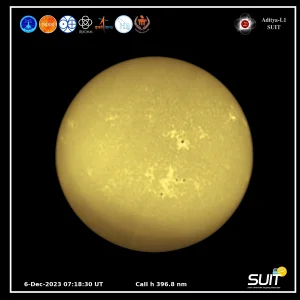
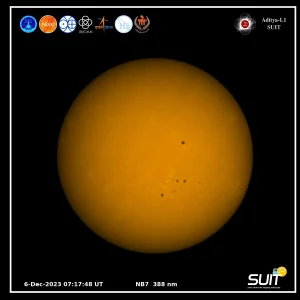

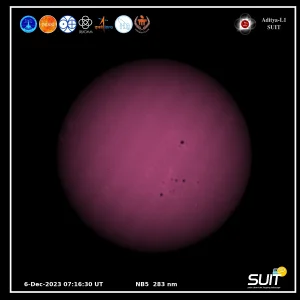

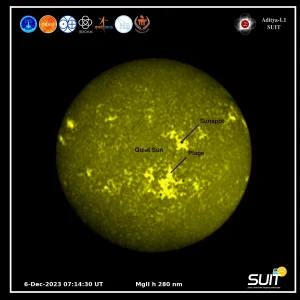
Last edited:
- Joined
- Jun 27, 2024
- Messages
- 284
- Likes
- 1,479
- Joined
- Jun 27, 2024
- Messages
- 284
- Likes
- 1,479
Video: Operation of Shutter of SUIT Instrument
- Joined
- Jun 27, 2024
- Messages
- 2,563
- Likes
- 8,182
- Joined
- Jun 27, 2024
- Messages
- 284
- Likes
- 1,479
Aditya L1 and Proba-3 to conduct joint solar observations in 2025

Aditya L1 and Proba-3 to conduct joint solar observations in 2025
What Aditya L1 and Proba-3 share in common is the coronagraph – an instrument designed to block the sun's bright rays and allow astronomers to view and study its periphery, nearby features or objects.
Latest Replies
-
Chinese Economy Watch
- E-195
-
Indian Air Force: News & Discussions
- midnight
-
Indian Special Forces
- Baseplate
-
GTRE GTX 35VS Kaveri
- vampyrbladez
-
Global 6th Generation Fighter Aircraft Projects
- randombully
-
Jokes Thread
- Yuyutsu
-
US: News & Discussions
- asaada
-
Indian Economy
- eastern_bhartiya




